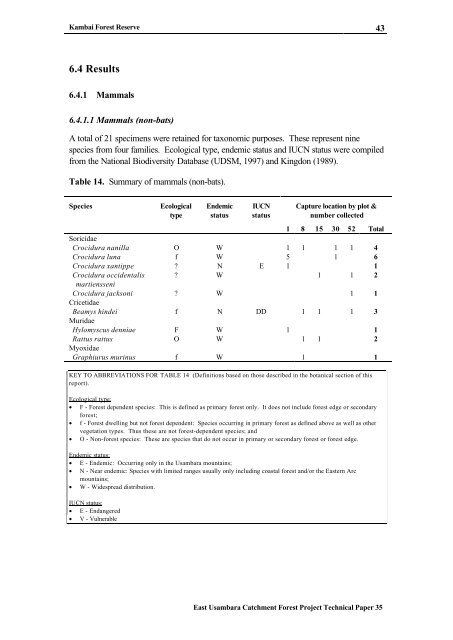Kambai Forest Reserve: A biodiversity survey. - Coastal Forests of ...
Kambai Forest Reserve: A biodiversity survey. - Coastal Forests of ...
Kambai Forest Reserve: A biodiversity survey. - Coastal Forests of ...
Create successful ePaper yourself
Turn your PDF publications into a flip-book with our unique Google optimized e-Paper software.
<strong>Kambai</strong> <strong>Forest</strong> <strong>Reserve</strong><br />
43<br />
6.4 Results<br />
6.4.1 Mammals<br />
6.4.1.1 Mammals (non-bats)<br />
A total <strong>of</strong> 21 specimens were retained for taxonomic purposes. These represent nine<br />
species from four families. Ecological type, endemic status and IUCN status were compiled<br />
from the National Biodiversity Database (UDSM, 1997) and Kingdon (1989).<br />
Table 14. Summary <strong>of</strong> mammals (non-bats).<br />
Species<br />
Ecological<br />
type<br />
Endemic<br />
status<br />
IUCN<br />
status<br />
Capture location by plot &<br />
number collected<br />
1 8 15 30 52 Total<br />
Soricidae<br />
Crocidura nanilla O W 1 1 1 1 4<br />
Crocidura luna f W 5 1 6<br />
Crocidura xantippe ? N E 1 1<br />
Crocidura occidentalis ? W 1 1 2<br />
martiensseni<br />
Crocidura jacksoni ? W 1 1<br />
Cricetidae<br />
Beamys hindei f N DD 1 1 1 3<br />
Muridae<br />
Hylomyscus denniae F W 1 1<br />
Rattus rattus O W 1 1 2<br />
Myoxidae<br />
Graphiurus murinus f W 1 1<br />
KEY TO ABBREVIATIONS FOR TABLE 14 (Definitions based on those described in the botanical section <strong>of</strong> this<br />
report).<br />
Ecological type:<br />
• F - <strong>Forest</strong> dependent species: This is defined as primary forest only. It does not include forest edge or secondary<br />
forest;<br />
• f - <strong>Forest</strong> dwelling but not forest dependent: Species occurring in primary forest as defined above as well as other<br />
vegetation types. Thus these are not forest-dependent species; and<br />
• O - Non-forest species: These are species that do not occur in primary or secondary forest or forest edge.<br />
Endemic status:<br />
• E - Endemic: Occurring only in the Usambara mountains;<br />
• N - Near endemic: Species with limited ranges usually only including coastal forest and/or the Eastern Arc<br />
mountains;<br />
• W - Widespread distribution.<br />
IUCN status:<br />
• E - Endangered<br />
• V - Vulnerable<br />
East Usambara Catchment <strong>Forest</strong> Project Technical Paper 35
















